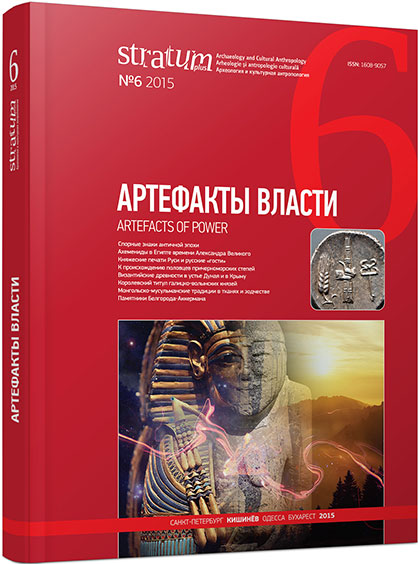Происхождение и пути миграции половцев в Северное Причерноморье по данным археологических источников
The Origin and Migration Routes of Cumans in the Northern Black Sea by Archaeological Sources
Author(s): Maksym V. KvitnytskyiSubject(s): History, Cultural history, Ethnohistory, Middle Ages, 6th to 12th Centuries
Published by: Издательский дом Stratum, Университет «Высшая антропологическая школа»
Keywords: Northern Black Sea coast; South-Western Siberia; Cumans; Kimaks; Kipchaks; zoomorphic sculpture
Summary/Abstract: The paper considers the problem of origin of the Cuman tribes of the Northern Black Sea area in the context of archaeological finds. The material collected during the research on the territory of Ukraine has allowed to define three groups of objects and sculptures, which mark the contact nomadic zone before moving to the northern Black Sea. These things are associated with forest-steppe zone of South-Western Siberia, the mountain woodlands of South-Eastern Siberia, as well as the North of Kyrgyzstan, South-Eastern and central areas of modern Kazakhstan. Most of the items-markers, as well as zoomorphic sculpture refers to the habitats of Kimak tribes. While Kipchaks are correlated with the anthropomorphic sculptures. The received results allow adjusting the findings on the penetration into the Black Sea, in the bulk, of Kipchak tribes and a small part of Kimaks. Southern Siberian finds spread in the South-Russian steppes, as well as correlation of details in funerary practice suggest the predominance of the Kimak tribes. The primary impulse for displacement of the Cumans can be associated with the lands of the Eastern and Central Kazakhstan. The migration also involved tribes associated with Khakassia and Mongolia.
Journal: Stratum plus. Археология и культурная антропология
- Issue Year: 2015
- Issue No: 6
- Page Range: 275-302
- Page Count: 28
- Language: Russian
- Content File-PDF

